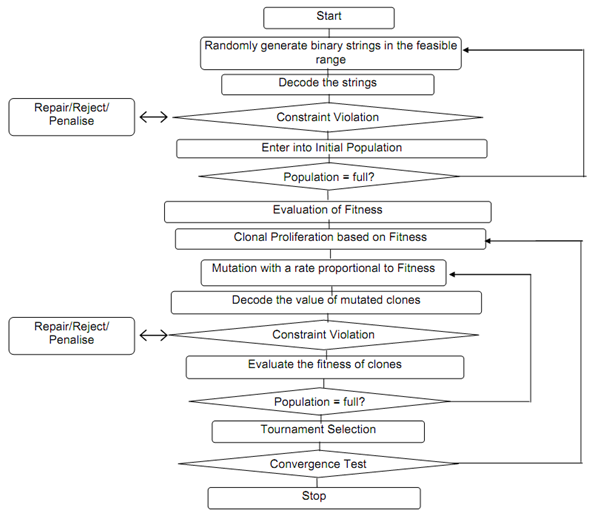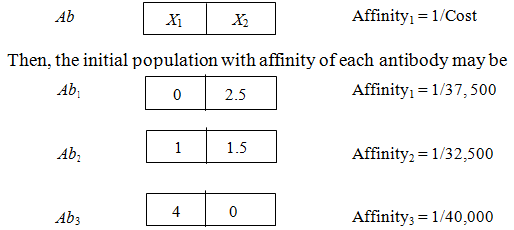Parameter Selection and Algorithm Details
The number of bits to encode a solution to the ELD problem based upon the decimal value to that the solution is essential, mostly in binary strings. Additionally, larger the number of bits to encode a resolution, greater is the exploration of search space. The antibody size population does have an impact upon the algorithmic performance and it should be accurately tuned to get the best possible solution. Likewise, the number of clones generated per antibody that is dependent on its fitness value and the hyper-mutation rate is to be controlled to fetch excellent results. In case of constraint optimization, affinity evaluation can be done employing Eq.23 converting into a fitness value to carry out a proportional mutated clone's selection. The fitness value to calculate the affinity of any antibody is described in the following expression as:
e(x) = {(k /(Ftcost))+ (ρ(x))}.................Eqn(23)
Here ε (x) is the fitness function for string x,
Ft cost is the cost associated along with that string and
ρ (x) is the extent of constraint violation the string.
Following figure represents the execution of the algorithm over a generic parameter optimization problem in computer integrated manufacturing via a flow chart. The algorithm starts along with the random generation of a binary string that is then decoded into actual values to verify any constraint violation. In section of any constraint violation, string penalizing, rejecting or repairing is done such to convert the infeasible strings into the feasible ones. This is entered the initial population otherwise this is randomly generated again and then decoded and then checked for violation, if the repairing strategy commits a feasible string.

This process is repeated iteratively till an arbitrarily fixed size of population is achieved. While the population becomes full after that each of the antibodies is evaluated and clones are produced based on fitness values. The mutation rate is not obtained uniform but remained a dependent on the fitness value of a specified clone. This is modeled as a function of the fitness value of the antibody to be mutated. Therefore, clones along with higher fitness are made liable to undergo mutation to a lesser extent as like compare to that lower fitness. It is followed by the decoding of the mutated clones into their actual values and an enquiry is made to observe any constraint violation. Repairing is complete in case of any type of constraint violation. Any infeasibility aroused is repaired and the consequent fitness value is estimated. It is repeated until all the clones from the temporary clonal population are endured to mutation. At last, selection is complete to select same number of mutated clones as there are in initial population. It completes one generation of the clonal selection algorithm. The convergence parameter could be set as maintained by an upper limit for number of iteration or the condition when each the strings selected for next generations are similar. An example of parameter optimization from production planning, mostly, a resource allocation problem is shown below.
Illustration 1
A company is enhancing a long range strategic plan for buying scraps metal for its foundry operations. The foundry can buy scrap metal in limitless quantities from two sources as: A and B. The company obtains the scrap daily in railroad cars. Such scrap is melted down, and lead and copper are extracted for employ in foundry processes. All railroad car of scrap from source A yields 1 ton of copper and 1 ton of direct or leads and costs $ 10,000. All railroad car of scrap from source B yields 1 ton of copper and 2 tons of direct or leads and costs $15,000. If the foundry requires at least 4 tons of lead per day and 2.5 tons of copper for the foreseeable future, how many railroad cars of scrap must be purchased per day from source A and source B to minimize the long range scrap metal cost.
Suppose X1 the carloads of scrap per day from source A and X2 be such per day from source B. after that, the specified problem can formulate as the given LP problem.
Min Cost = 10,000 X1 + 15,000 X2 .............. Eq(24)
Subject to X1 + 2 X 2 ≥ 4 .............. Eq(25)
X1 + X 2 ≥ 2.5 ................. Eq(26)
Suppose that start with real coding of antibodies' population along with 3 strings in it. If the common encoding schema be:

Based upon the affinity of the antibodies, supposes generate 1, 2 and 3 clones respectively for Ab3, Ab1 and Ab2.
And now, performing maturation process as a bit swapping hyper-mutation ensuring the probability of hyper-mutation of a clone to be inversely proportional to its affinity, we have matured pool as:
|
|
X1
|
X2
|
Affinity
|
|
Ab1
|
0
|
2.5
|
1/37,500
|
|
Ab2
|
2.5
|
0
|
1/25,000
|
|
Ab3
|
1
|
1.5
|
1/32,500
|
|
Ab4
|
1
|
1.5
|
1/32,500
|
|
Ab5
|
1.5
|
1
|
1/15,000
|
|
Ab6
|
0
|
4
|
1/60,000
|
Using refusing strategy for infeasible strings, we have the given population for next iteration,
|
|
X1
|
X2
|
Affinity
|
|
Ab1
|
0
|
2.5
|
Affinity1=1/37,500
|
|
Ab2
|
1
|
1.5
|
Affinity3= 1/32,500
|
|
Ab3
|
1
|
1.5
|
Affinity4 = 1/32,500
|
Proceeding in the same fashion for a number of iterations till each the strings selected for next generation are similar, it can be determined that the optimal solution for resource allocation is X1 = 1 and X2 = 1.5.